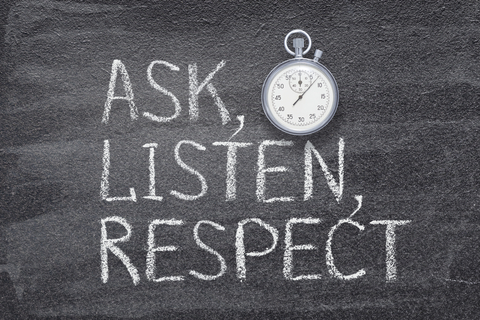 As educators, sensitive topics are bound to come up in the classroom, whether you meet in-person or online. This can be especially true in the social studies, which is ultimately the study of human relationships and the functioning of society. Students’ identities, lived experiences, and what they see and hear in the media can all shape their perspectives on the many societal topics covered in class, including race, class, religion, immigration, gender identity, sexual orientation, wealth, globalization, or political viewpoints.
As educators, sensitive topics are bound to come up in the classroom, whether you meet in-person or online. This can be especially true in the social studies, which is ultimately the study of human relationships and the functioning of society. Students’ identities, lived experiences, and what they see and hear in the media can all shape their perspectives on the many societal topics covered in class, including race, class, religion, immigration, gender identity, sexual orientation, wealth, globalization, or political viewpoints.
Some teachers may be tempted to avoid teaching about certain issues or topics. But with the right preparation, you can, and certainly should, create a safe space for students to respectfully communicate and have dialogue on sensitive, yet critical, topics. Listening to and learning about different viewpoints also provides an authentic opportunity to further students’ critical thinking skills.
We’ve put together some resources and tips for creating and supporting productive and respectful discussions on “tough topics” in the social studies classroom. We start with a class activity where students set ground rules for themselves and their peers, and end with a collection of trustworthy facilitation guides.
Class Activity: Creating Guidelines for Respectful Dialogue
When creating “rules” for classroom discussions on sensitive topics, use this brief student-driven activity instead of simply giving students a list of guidelines. This will give students ownership and buy-in as they co-create guidelines with their classmates.

The three-step activity is meant to be used before introducing your lesson that focuses on a “tough topic.” However, you can also jump straight to #2 below if you feel you need to pause in the middle of an on-going lesson to set some ground rules before proceeding. This activity can be used if you meet with students face-to-face or if you meet virtually.
Step #1
First, introduce your topic. Ask students what they think about when they hear a word or phrase that is central to your lesson’s content. For example, if you are starting a lesson about immigration – you might ask them about the word “immigrant” or the phrase “immigration to the U.S.” (Other topical words might be “racism,” “discrimination,” “environmental justice,” etc.) Ask students to define this word to the best of their ability. Then, ask them what feelings or thoughts come up when they think about discussing this topic with other classmates in small groups and as an entire class. Ask them to write down why they feel or think that way.
Next, ask students to write down what a supportive classroom environment would look like when having conversations about this topic. You can prompt them further by asking, “What kind of tone, words, and attitudes would be present in the classroom? How do you hope people respond to different viewpoints? How can the teacher help support an environment that feels safe and inclusive?”

Step #2
In small groups, ask students to share some of their ideas and as a group, develop a list of rules and/or guidelines for having respectful conversations and productive discussions about the tough topic. A rule might be “No generalizing.” If the lesson is on immigration, a generalization example is saying “All people from this place are like this!” or using phrases like “always” or “never.” Examples of guidelines students create are: “Don’t interrupt – let someone finish speaking” or using active listening skills like: “I respectfully disagree because _______ (give evidence).”
When teaching in a virtual classroom, it may be helpful to ask the students to suggest specific rules or guidelines that apply for fostering a safe “online learning” environment as well. For instance, they may suggest that “online only” classroom experiences require different or modified processes to ensure that every student has an opportunity to express their viewpoint. What would guidelines look like for an online discussion board? Since you can’t hear someone’s tone, ask students what a respectful dialogue would look like in writing. What about challenges unique to video-conferencing, where there are less non-verbal cues than face-to-face interactions and sometimes pesky video time lags. Address these virtual communication challenges openly with the students, and keep in mind that some students may be more hesitant to speak out over video conference. You may want to point out how students can virtually raise their hand, a feature of most video-conferencing software. Students might include the use of the “hand raise” in their guidelines.
Step #3
As a class, ask someone from each group to read through their group’s list. As students read new themes, write down or paraphrase their suggestions on the board. After every group has read their guidelines, ask the class to notice the patterns. Which themes and guidelines are represented? Is there anything missing? The guidelines should cover how to disagree, how to speak respectfully, how to avoid generalizing or making assumptions, and how to share opinions based on evidence or reasoning.

You can add a few of your own guidelines if there are any gaps. A great place for inspiration is The University of Michigan Center for Research on Learning and Teaching’s six “guidelines for productive discussions” below. Ask students to add anything to their own lists that they want to include.
a) Listen respectfully, without interrupting.
b) Respect one another’s views.
c) Criticize ideas, not individuals.
d) Commit to learning, not debating.
e) Avoid blame and speculation.
f) Avoid inflammatory language.
Depending on your lesson or class project, you can ask each group to abide by their own group’s guidelines, or use the list created on the board to guide the whole class.
Resources for Preparing and Facilitating Classroom Discussions on “Tough Topics”
The linked facilitation guides below include suggestions for creating a strong foundation for discussing sensitive topics in your classroom. You’ll find tools for monitoring classroom dynamics, responding to tough moments, and guiding students through personal reflection and whole-class de-briefing.
• Let’s Talk! Facilitating Critical Conversations with Students from Teaching Tolerance. This extensive guide’s recommendations are aligned with the organization’s Social Justice Standards. It provides strategies for laying the groundwork to facilitate difficult classroom conversations, gauging and responding to the “emotional temperature” in the classroom, and how to de-brief at the end of class so students can reflect on not only what they learned, but their experience of learning.
• 10 Tips for Facilitating Classroom Discussions on Sensitive Topics by Alicia L. Moore and Molly Deshaies. This short guide offers a step-by-step resource sheet for teachers on setting up, guiding, and de-briefing difficult and important conversations in the classroom. Using the “S.E.N.S.I.T.I.V.E” guidelines to highlight the main ideas, this resource offers important reminders about preparing yourself for facilitation, as well, such as reflecting on and recognizing your own unconscious biases.
• Guidelines for Discussing Difficult or High-Stakes Topics from the University of Michigan’s Center for Research on Learning and Teaching. This resource offers tips on responding to both spontaneous and planned discussions, as well as handling issues that involve the instructor’s identity.
• The Difficult Dialogues Guide from Vanderbilt University’s Center for Teaching includes a nice overview of “the basics” in preparing discussions on difficult topics. It also provides specific strategies, such as the “Five Minute Rule” for spotlighting specific perspectives and the “Critical Incident Questionnaire” to prompt student reflection, when hot topic moments arise or when a classroom discussion becomes very tense.
Teachers Need to Reflect on Tough Topics Too!
Finally, don’t forget to continuing to learn and further your own knowledge on the issues and identities that may be different from your own, while uncovering your own unconscious biases. Teaching Tolerance has a series of free webinars, from discussing race and racism with your students, to discussing gender identity, to furthering your own understanding of intersectionality and how you can better support your students.
You can also ask other teachers in your school for ideas and guidance on how they facilitate discussions on sensitive topics in their class, or simply ask how they handle certain conversations. This can build an “on the ground” community with other teachers interested in sharing their experiences or learning with you.
Image credits: Refugees in Croatia (djenkaphoto/istockphoto.com); Group of students talking (ID 170383128 ©Kadettmann, Dreamstime.com); Student raising hand (ID 85799700 ©Diego Vito Cervo, Dreamstime.com); Chalkboard (ID 160035450 ©Yuryz, Dreamstime.com)


